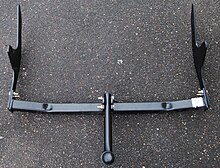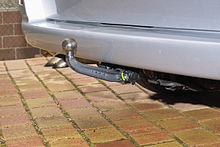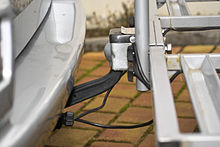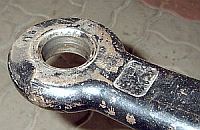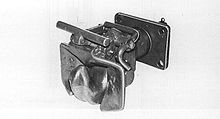trailer hitch
A trailer coupling or a trailer hitch is a device with which a vehicle - for example a car , truck or bicycle (see bicycle trailer ) - is connected to a trailer . Depending on the type of towing vehicle and the trailer, there are four types:
- the pin coupling , common in agriculture and forestry
- the ball head coupling , common in cars and older bicycle trailers with a high drawbar
- the jaw coupling on trucks and tractors
- the fifth wheel on articulated lorries.
Types in which coupling hooks with appropriate eyes are used are less common.
The regulations to be applied uniformly in the European Union are summarized in EC Directive 94/20.
history
Pin coupling
The first detachable trailer hitches are known from 1904, but a "trailer industry" did not emerge until 1912. In the 1920s, different coupling systems were used; In 1925 alone, 17 different pin couplings were counted. Simple pin couplings are still used for unbraked trailers in agriculture, forestry and construction sites.
Jaw coupling
The manufacturer Rockinger developed an automatic, self-closing jaw coupling in 1927, for which it received a US patent in 1932. The manufacturer Ringfeder from Krefeld produced a similar product for the railway as early as 1923 . These systems of the automatic self-closing process when the clutch is engaged are being used worldwide in commercial vehicles.
Fifth wheel
A fifth wheel with king pin is required for the semi-trailer or semi- trailer . The first patents for a detachable semi-trailer were granted in 1932, but the first articulated truck was introduced as early as the 1920s with the “Oekonom large area wagon”.
Ball coupling
Detachable ball quick-release fasteners were already being offered for motorcycle harnesses in the early 1930s . On March 14, 1934, Franz Knöbel received a patent for the ball head coupling. With this invention, the manufacturer Westfalia achieved worldwide fame. The diameter of the sphere at that time of 50 mm is still the norm today. For light trailers (without / with overrun brake) the ball head coupling is today's coupling standard. The non-“automatic” ball head coupling is permitted for trailers in agriculture and forestry as well as with a permissible total trailer weight of up to 3500 kg.
Car
In passenger cars , the ball coupling is used. A bracket with a standardized ball with a diameter of 50 mm serves as the towing device. On the trailer there is a counterpart on the drawbar with a ball socket with a rear lock. This can be opened by lifting a lever. If the two are coupled together, the ball socket is rotatably mounted on the ball and secured against lifting. This enables the trailer to follow the towing vehicle in an articulated manner. Furthermore, the trailer hitch can also be used as a basis for other transport devices such. B. serve bicycle racks . An important criterion for the load capacity is the permissible support load , which is usually 75 kg.
D value
The fatigue strength against the effects of forces caused by driving between the towing vehicle and the trailer on the interposed trailer coupling structure is referred to as the D value and is given in kilo newtons (kN). The value can be found on the nameplate . This value of a given trailer coupling, together with the mass of the towing vehicle and any total trailer mass specified in the registration documents or on the nameplate, forms the basis for calculating the permissible trailer load. The D-value is determined and checked once based on a suitable construction and thus remains unchangeable.
With the introduction of the D-value, the specification of the trailer load (GA) and the permissible total weight (GF) that had been customary up to that point on the type plate of the trailer coupling is no longer applicable. Only the D-value and the permissible vertical load are given. The total weight of the towing vehicle and the trailer load are variable values, although it should be noted that the chassis manufacturers and their peripherals limit the total weight of a train.
The required D-value according to directive 94/20 / EG or also according to ECE - can be calculated according to
- With
- : required D-value in kilonewtons (kN)
- : technically permissible total mass of the towing vehicle in tons (t)
- : technically permissible total mass of the trailer in tons (t)
- : Gravitational acceleration ( )
determine.
The D value of the trailer coupling must always be higher than the required D value. Calculation of the maximum permissible trailer load on a trailer coupling with a given D value according to Directive 94/20 / EC
The trailer load must always be less than the permissible trailer load.
Detachable towbars
In addition to the rigid trailer hitches, there are also versions with a removable ball neck, which then does not interfere with operation without a trailer. A removable ball neck is compulsory in accordance with EU Directive EC Directive 94/20 of May 30, 1994, Annex VII, Section 2.1.4 (PDF) as soon as the label or the space provided for it is covered by the ball neck.
Depending on the direction from which the removable part is attached to the vehicle, a distinction is made between vertical, inclined and horizontal variants. These can also usually be locked so that they cannot be accidentally released by themselves or through external influences and cannot be removed by unauthorized persons.
In some versions, when the ball head is removed, the connector protrudes from under the bumper, in others the socket can also be swiveled upwards. The view of the rear of the vehicle is then no longer disturbed by the recordings. There are also devices with a mechanically or electrically retractable trailer coupling which, when not in use, can be swiveled in behind the bumper outside the field of vision.
In some countries, such as Slovakia, it is mandatory that every detachable coupling must actually be removed when not in use, although this is not explicitly named in accordance with EC Directive 94/20.
Impact protection
The use of an impact protection (APS) made of rubber reduces the risk of damage to the towing vehicle when coupling.
Electrics
truck
The self-locking jaw coupling, which was developed from the simple pin coupling, is used for trailers on trucks (mostly over 3.5 t). The counterpart on the drawbar of the trailer is called the coupling eye or eye. The coupling pin is raised by swiveling the operating lever towards the truck body and engages in this position. If the eye of the trailer drawbar is then pushed into the coupling mouth, the bolt falls through the eye with the aid of spring force, automatically engages in this position and the coupling is connected. The so-called feeler pin (in the picture diagonally above the coupling jaw ) shows whether the bolt is securely engaged : In the locked position, its end is flush with the surrounding housing. If the coupling is not yet locked, the pin protrudes clearly. This device is referred to as a “feeler pen” because the operator can clearly determine whether the clutch is engaged, even in complete darkness, by scanning with his hand. To uncouple the trailer, the lever is also swiveled forward until the bolt engages, so that the towing vehicle can then be driven away from the parked trailer.
Then there is the plug for the electrical supply. The compressed air connections for the brakes are also required. There is an older single-line and a more modern dual-line braking system.
Predecessors of these towbars were not automatic, but simply a bolt was pushed through the mouth and the eye from above and secured with a pin at the bottom. This type is often still used in tractors , forklifts or in the front area of trucks. The latter are mainly used as towing devices, for this purpose there are special tow bars with trailer eyes on both sides, which can be used to connect the broken-down truck to another truck as a towing vehicle. But this front coupling is also used for maneuvering trailers, as the view of the trailer is more favorable and the combination then has a smaller turning circle.
There are two different types of trailers for trucks. A distinction is made between trailers with a height-adjustable drawbar, which do not transfer vertical forces, and rigid trailers, which transfer vertical forces. The former are generally referred to as turntable trailers and the latter as central axle or rigid drawbar trailers.
Towing vehicle with fifth wheel
D value
The D-value for turntables is calculated as follows in 94/20 / EG or ECE -R 55 , just like for cars :
Abbreviations:
- : required D-value in kilonewtons ( )
- : Gravitational acceleration ( )
- U: fifth wheel load in tons (t)
- : technically permissible total mass of the towing vehicle in tons ( )
- : Total mass of the trailer in tons ( )
The D value of the coupling must be greater than or equal to the calculated value for the train combination.
Towing vehicle with central axle trailer
D c value
The D c value is the equivalent of the D value for center-axle trailers. The D c value is in accordance with 94/20 / EG or ECE -R 55
- With
- : required value in kilonewtons ( )
- : Gravitational acceleration ( )
- : technically permissible total mass of the towing vehicle in tonnes ( ), including the vertical load of the center axle trailer
- : Sum of the axle loads of the maximum loaded center axle trailer in tons ( )
certainly.
The D c value of the coupling must be greater than or equal to the value calculated for the train combination.
V value
The V-value is the theoretical reference value of the vertical force amplitude that is exerted on the coupling by the central axle trailer with a technically permissible maximum mass of more than 3.5 tons. The V-value is used in dynamic tests to determine the vertical forces. It is usually given in kilonewtons.
The V-value is the theoretical vertical drawbar force that is exerted on the coupling by the center-axle trailer with a technically permissible maximum mass of more than 3.5 tons. The V-value is used in dynamic tests to determine the vertical forces. The value is calculated according to ECE-R55:
- With
-
: vertical comparison acceleration in the coupling point in
- for vehicles with air suspension (on the rear axle) or comparable suspension
- for vehicles with other suspension
- : Sum of the axle loads of the maximum loaded center axle trailer in tons ( )
- : Distance from the center of the towing eye to the center of the axle assembly in meters ( )
- : Length of the trailer without drawbar in meters ( )
Note: (If the result is a value less than 1.0, then the value 1.0 must be used.)
The V value of the coupling must be greater than or equal to the calculated V value.
NATO coupling
Another type of trailer coupling is the hook or NATO coupling. This type of towbar has been banned in civil public road traffic in Austria since the late 1970s. In Germany, the automatically closing hook couplings, which were introduced from the 1970s, can be approved without restriction, as they have a national test mark consisting of a wavy line and manufacturer number. Due to the larger diameter of the hook compared to the bolt of the civil coupling, only trailers with a corresponding towing eye can be attached. There are constant rumors of a ban on hook couplings. However, these are essentially based on two points that have long been improved. In the early days, during the Second World War, the towing eye was bent out of a tube that broke under heavy loads. Modern drawbar eyes are massive forged parts made of steel. In addition, earlier hook couplings were not automatically closing, which precluded their use on public roads. The Americans parted with the hook coupling a good ten years later. However, this species is still used in the military. One reason for this is the usability in the field. Their construction makes it possible to pull a trailer even in difficult terrain.
Two-wheelers
With two-wheelers, there are basically two different ways of hitching a trailer. On the one hand, a similar system as in the car with a smaller (diameter 25 mm) coupling ball on the towing vehicle. In the case of bicycles, this is usually attached directly behind or under the saddle, in the case of mopeds or mopeds on the rear luggage rack. With this system, single-axle handcarts with a high drawbar can be coupled. A hemispherical shell on the drawbar is pressed onto the coupling ball by a press block with a recess. Other systems work with an eyelet and a pin.
For bicycle trailers , a coupling system is becoming increasingly widespread, in which the coupling (usually on the left) is located on the side near the rear axle of the towing vehicle, either together with a side stand on the chain and side struts (frame tubes) or with the axle nut clamped to the axle. The coupling can again be articulated via a ball. If, on the other hand, it is more form-fitting, the drawbar running backwards at an angle has a relatively stiff helical spring integrated as a joint. The introduction of the “inertial force” of the trailer when braking (only) the towing bike is less than half as high at the axle height, so that it is less “lifted” (relief of the rear axle). Trailer swaying forces across the direction of travel also have less of an effect on the bike with the shorter lever. Both effects make it safer to ride, even when standing and kicking . However, driving on tight right-hand bends is hindered because the rear wheel hits the drawbar.
Single-track trailers , whether for bicycles or motorized vehicles, require a type of coupling and drawbar that connect the trailer to the towing vehicle in a torsionally rigid manner and thus hold it upright with respect to its longitudinal axis. However, the coupling and drawbar must be articulated by two bending directions for hilltop and cornering. So two bolts (roughly) in the extension of the rear wheel axle of the two-wheeler form a (interrupted) horizontal articulation axle. At the front, the trailer has a joint with an approximately 15 cm long, vertical articulation axis. Both form two edges of an elongated tetrahedron , the four other edges of which are formed by four slender tubes of a three-dimensional drawbar (usually collapsible and easily dismantled). Narrow, low construction and loading allows you to step out of the saddle, the one-wheel trailer leans into every curve and follows exactly in the lane .
In the case of motorcycles, there are individual suppliers of trailer hitches of the passenger car 50 mm standard. After the motorcycle has hardly been used as a pure transport vehicle since the late 1960s at the latest, and motorcycles with trailers e.g. B. are limited to 60 km / h according to the German StVO § 3 Paragraph 3, this type of team has largely disappeared from the streets in Central Europe.
Special vehicles
Historically, other attachment systems for special vehicles are known. The German Wehrmacht used the standard bulky hooks on motorcycle combinations such as the Zündapp KS 750 and chain sprockets for light towing loads . The connection of several trailers was also used in a similar way for the IF8 infantry cart for horse and carts . A limber hook was sometimes used on 1.5-ton trucks such as the Steyr 1500 A. A backlash-free double-pin coupling was used for bus trailers.
Legal
General rules
In Germany, a towing device is required for multi-lane vehicles and is regulated together with trailer couplings in Section 43 of the StVZO "Devices for connecting vehicles" (extract):
- Trailer hitches must work automatically
- However, non-automatic trailer hitches are permitted
- on tractors and on self-propelled machines and forklifts, if the driver can observe the coupling process from his seat,
- on motorcycles and passenger cars,
- on trailers behind tractors in agricultural or forestry operations,
- For connecting other motor vehicles with single-axle trailers or two-axle trailers with an axle spacing of less than 1.0 m and a permissible total weight of no more than 3.5 t.
- Multi-lane vehicles with more than one axle must have a towing facility at the front
Notes on towing a trailer
Permissible total weight of the train
The note "ZUL.GES.-GEW.D." can be added to the vehicle registration document under item 33 (remarks). ZUGES MAX ......... KG ”must be noted. This defines the maximum permissible total weight of the train (combination of towing vehicle and trailer). The vehicle owner / driver must observe this restriction.
Admission requirements
In Germany, a retrofitted trailer coupling that does not have EU approval must be checked and approved by an officially recognized expert.
Is part 1 of the registration certificate under point 22 (comments and exceptions) ww. AHK lt EGTG / ABE. Noted (official abbreviation for w ahl w else A n h Änger k upplung l au t EG - T yp g appro val or A ENERAL B rofessional e rlaubnis) is the vehicle for growing a decrease free trailer coupling with EU approval planned.
The requirements for an acceptance-free extension of the AHK according to Section 19 Paragraph 3 StVZO are as follows in Germany:
- The trailer coupling must have EU approval (certification mark starting with e). The E-mark indicates that the technical component in question is approved within the EU; further testing of the attachment is then not required.
- Equipment without EU approval or E-mark must be checked after installation by a monitoring organization (ÜO such as FKÜ, KÜS, GTÜ) or the technical test center (TP such as DEKRA or TÜV). The correct attachment of the parts and compliance with any associated requirements are checked and, once the test has been passed, an acceptance test is issued.
- However, the KBA equates old AHKs with a ~ test mark to the E mark and does not require any entry, only that you carry the installation instructions with you. See link KBA information system
- If the facility has not been entered in the vehicle documents with the help of the general operating license , the EC operating license or the acceptance of changes by the licensing authorities, the document must be carried with you while driving or driving the vehicle.
- The permissible trailer load must be checked using the so-called D value of the trailer coupling.
In Austria, approval depends on whether a device has already been entered in the type certificate . Only if none is entered does it have to be checked and entered by the verification body of the respective state government .
See also
literature
- Karl-Heinz Dietsche, Thomas Jäger, Robert Bosch GmbH: Automotive pocket book. 25th edition, Friedr. Vieweg & Sohn Verlag, Wiesbaden 2003, ISBN 3-528-23876-3 .
- Jürgen Kasedorf, Richard Koch: Service primer for vehicle electrics. 14th revised edition, Vogel Buchverlag, 2001, ISBN 3-8023-1881-1 .
Web links
- Pin assignment for trailer hitches, kfztech.de
- Pin assignment at 12 V and at 24 V , unimogfreunde.de
- Assembly of the trailer coupling
- KBA information system type approval procedure No. 07-01
Individual evidence
- ↑ Directive 94/20 / EC of May 30, 1994
- ^ Olaf von Fersen : A century of automobile technology - commercial vehicles. VDI-Verlag, Düsseldorf 1987, ISBN 3-18-400656-6 , p. 264.
- ↑ Castner: Accident-proof couplings for trucks. In: Polytechnisches Journal . 341, 1926, pp. 141-144.
- ^ Jost-World history Rockinger (accessed on March 26, 2014)
- ↑ U.S. Patent 1939463
- ↑ U.S. Patent 1990700
- ↑ Oekonom large area trolley
- ↑ Westfalia Automotive GmbH celebrates the trailer coupling - patent certificate issued 80 years ago ( memento from March 25, 2014 in the Internet Archive ) at: westfalen-blatt.de , March 15, 2014, accessed on March 25, 2014
- ↑ See § 43 (4) StVZO.
- ↑ ECE regulations -ECE-R 55
